Found a total of 10000 related content

CentOS: The Choice for Server Environments
Article Introduction:CentOS is widely selected as a server operating system because it is stable, secure and free. 1.CentOS is based on RHEL, providing enterprise-level stability and a life cycle of up to 10 years. 2. It has rich software packages and strong community support. 3. Simple installation, use yum management software package, and intuitive configuration. 4. Improve server management efficiency through command line tools, regular backups and log management. 5. Optimize server performance by adjusting kernel and network parameters.
2025-05-09
comment 0
374

How to charge for pagoda panels
Article Introduction:BT Panel is free, open-source server management software. Costs arise from the underlying server infrastructure (VPS/dedicated server rental) needed to run it, including domain name, SSL certificate, and bandwidth. Pricing depends entirely on the h
2025-03-07
comment 0
1167

How to Run an SMS Portal with playSMS in Linux
Article Introduction:This guide provides a comprehensive walkthrough for installing the open-source SMS management software, playSMS, on a Linux server. It's a powerful tool for efficient SMS communication management.
System Requirements:
Before beginning, ensure your s
2025-05-11
comment 0
362
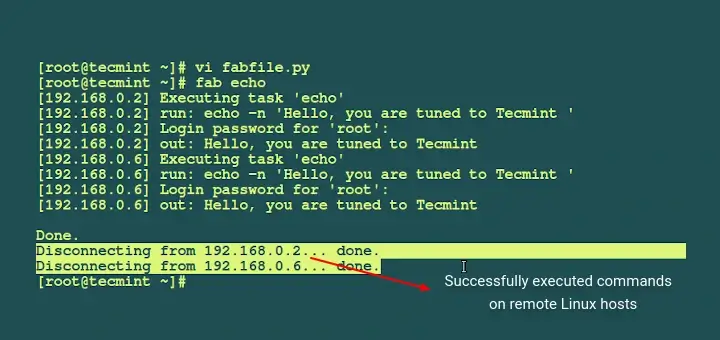
Fabric - Run Shell Commands Remotely Over SSH in Linux
Article Introduction:In the ever-changing world of software development, efficient remote server management is crucial. Whether you are a system administrator, a software engineer, or a software developer, being able to run Linux commands on remote servers is a common ta
2025-06-03
comment 0
419

Recommended software for Mac in operation and maintenance
Article Introduction:Mac operation and maintenance tools are recommended, creating an efficient working environment: Terminal emulator: iTerm2, enhance efficiency and beautiful remote connection tool: Termius, secure management of multiple server code editor: VS Code, support multiple languages and rich extension file manager: enhance Finder skills, improve efficiency monitoring tool: Datadog or Prometheus, promptly discover server exception log management tool: ELK stack, collect, analyze and visual log data Database management tool: Sequel Pro or Postico, graphical management database performance optimization: regular cleaning of system garbage, reasonable allocation of resources and timely update software
2025-04-12
comment 0
1010
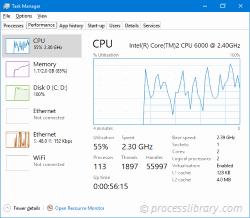
ddrprov.dll - What is ddrprov.dll?
Article Introduction:What is ddrprov.dll doing on my computer?
ddrprov.dll is a module belonging to Systems Management Server from Microsoft Corporation.
Non-system processes like ddrprov.dll originate from software you installed on your system. Since most applicat
2024-10-24
comment 0
349
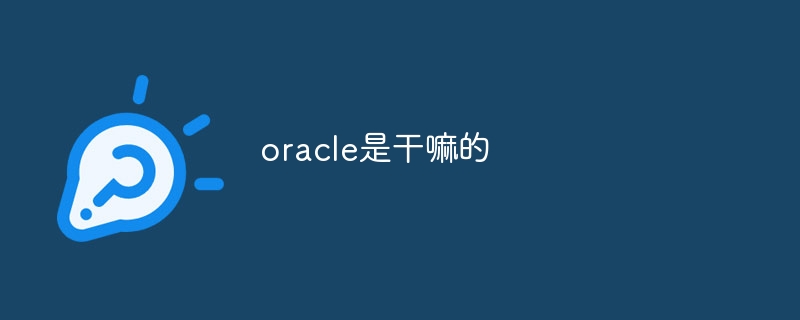
What does oracle do
Article Introduction:Oracle is the world's largest database management system (DBMS) software company. Its main products include the following functions: relational database management system (Oracle database) development tools (Oracle APEX, Oracle Visual Builder) middleware (Oracle WebLogic Server, Oracle SOA Suite) cloud service (Oracle Cloud Infrastructure) analysis and business intelligence (Oracle Analytics Cloud, Oracle Essbase) blockchain (Oracle Blockchain Pla
2025-04-11
comment 0
484

CentOS: A Community-Driven Linux Distribution
Article Introduction:CentOS is a stable, enterprise-grade Linux distribution suitable for server and enterprise environments. 1) It is based on RedHatEnterpriseLinux and provides a free, open source and compatible operating system. 2) CentOS uses the Yum package management system to simplify software installation and updates. 3) Support advanced automation management, such as using Ansible. 4) Common errors include package dependency and service startup issues, which can be solved through log files. 5) Performance optimization suggestions include the use of lightweight software, regular cleaning of the system and optimization of kernel parameters.
2025-04-17
comment 0
804

What does java middleware mean? Definition and typical applications of middleware
Article Introduction:Java middleware is a software that connects operating systems and application software, providing general services to help developers focus on business logic. Typical applications include: 1. Web server (such as Tomcat and Jetty), which handles HTTP requests; 2. Message queue (such as Kafka and RabbitMQ), which handles asynchronous communication; 3. Transaction management (such as SpringTransaction), which ensures data consistency; 4. ORM framework (such as Hibernate and MyBatis), which simplifies database operations.
2025-05-28
comment 0
823

The Purpose of IIS: Serving and Managing Web Content
Article Introduction:IIS is a web server software developed by Microsoft to host and manage websites. 1) IIS can handle static and dynamic content, 2) Provide management tools that seamlessly integrate with Windows, 3) Support HTTP, FTP, SMTP and other protocols, 4) Provide security functions such as SSL/TLS encryption, and 5) Optimize website performance through load balancing, caching, etc.
2025-04-15
comment 0
1128

CentOS: An Explanation of the Decision-Making Process
Article Introduction:CentOS is suitable as an enterprise-class server operating system because it is stable, secure and free. 1) It is based on RHEL and provides high compatibility with RHEL. 2) Use yum for package management to ensure that the software is easy to install and update. 3) The community regularly releases security patches, with a support cycle of up to 10 years.
2025-04-25
comment 0
395

Using CentOS: A Guide for System Administrators
Article Introduction:CentOS is an open source operating system based on RedHatEnterpriseLinux, suitable for server environments. 1. Select the appropriate media and options during installation and configure network, firewall and user permissions. 2. Use useradd, usermod and systemctl commands to manage users and services, and update software packages regularly. 3. Basic operations include using yum installation software and systemctl management services, and advanced features such as SELinux to enhance security. 4. Check the system log to solve common errors. Optimizing performance requires monitoring resources and cleaning of unnecessary files.
2025-04-22
comment 0
325

What are the security policies of php on centos
Article Introduction:Detailed explanation of CentOS server PHP security policy: Building a solid protection system This article will explore in-depth how to build a secure PHP operating environment on the CentOS system, covering multiple aspects such as system level, PHP configuration, permission management, HTTPS encryption and security monitoring, etc., to help you effectively reduce the risk of server attacks. Server security is a continuous improvement process that requires regular review and updates to security policies. 1. System security cornerstone system update: Keep the latest version of the CentOS system and all software packages, install security patches in a timely manner, and plug known vulnerabilities. Firewall protection: Use Firewalld to finely control server network access, and only necessary ports (such as HTTP port 80 and H
2025-04-14
comment 0
610

IIS: Managing Websites and Web Applications
Article Introduction:IIS is a web server software developed by Microsoft to host and manage websites and web applications. Here are the steps to efficiently manage IIS: 1. Create websites and web applications, using PowerShell commands such as New-WebSite and New-WebApplication. 2. Configure the application pool to optimize performance and security. 3. Use IIS Manager or PowerShell scripts for daily management, such as starting, stopping and viewing website status. 4. Use advanced features such as URL rewriting, load balancing and cluster management to improve SEO and website performance. 5. Troubleshoot common errors by viewing IIS log files. 6. Optimize performance, including compressing static content, setting cache policies and optimization
2025-04-23
comment 0
554

A Comprehensive Guide to Using PuTTY for SSH into Linux
Article Introduction:Securely connect to a remote Linux server with PuTTY, whether you are an experienced developer or a beginner, PuTTY is a reliable tool. This article will guide you on how to connect to a Linux server via Secure Shell Protocol (SSH) on a Windows operating system.
Introduction to PuTTY
PuTTY is an open source and free Windows SSH client. It allows users to remotely access the computer network and run commands as if they were sitting in front of a terminal. It is a multi-functional tool that is widely used in network management, software development and other IT-related fields.
Download and install PuTTY
Getting started with PuTTY is very easy. Visit PuTTY official download page,
2025-03-15
comment 0
529

How to Start, Stop, and Restart Services in Linux
Article Introduction:Linux service management is a must-have skill for Linux system administrators and users. A service is a process running in the background, providing various functions, such as a web server, a database, or a network service. This article will guide you on how to start, stop, and restart Linux services.
Why start, stop or restart the service?
Starting the Service: Services may be required to start after software is installed or when certain services are not automatically started when the system starts.
Stop Service: Stop Service can free up system resources or prevent unwanted programs from running.
Restart the service: If the service fails or after a configuration change is made, restarting is usually the fastest way to resolve the problem.
Key commands for managing services
In Linux, management services are the most common
2025-05-09
comment 0
1089
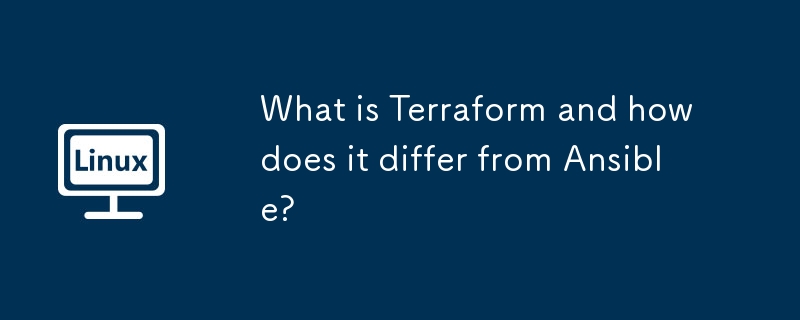
What is Terraform and how does it differ from Ansible?
Article Introduction:Terraform is an infrastructure-as-code tool for declaratively creating and managing infrastructure across cloud platforms; Ansible is a configuration management tool for automated configuration after the server runs. 1.Terraform defines the expected infrastructure state in a declarative manner, which is suitable for building an environment from scratch or large-scale changes; 2.Ansible performs tasks through YAML scripts, which is suitable for deploying applications, installing software and maintaining system state; 3.Terraform maintains state file tracking resources, while Ansible checks and implements configurations every time it runs; 4. The two are often used in combination: Terraform builds the infrastructure first, and Ansible then configures it.
2025-06-26
comment 0
595
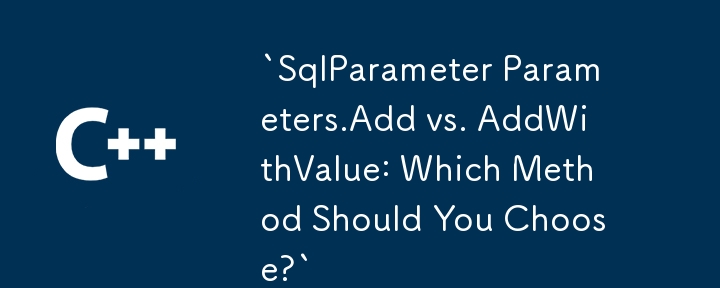

Dave The Diver: How To Catch Spider Crabs
Article Introduction:In Dave The Diver, there are some creatures that are not easy to catch. Or, catch alive that is. The spider crab is one of those very species, making it seem like the only way to bring these crustaceans back up to land is to viciously crack them up w
2025-01-10
comment 0
811



















